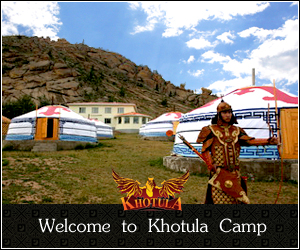Budda Zanabazar
 Zanabazar was the 16th Incarnation of Javzandamba. The name Zanabazar, a combination of the word zana, which is derived from a Sanskrit word meaning “knowledge” or “wisdom”, and the word bazar, meaning “thunderbolt”. Thus in English his name might be rendered “thunderbolt of wisdom”.
Zanabazar was the 16th Incarnation of Javzandamba. The name Zanabazar, a combination of the word zana, which is derived from a Sanskrit word meaning “knowledge” or “wisdom”, and the word bazar, meaning “thunderbolt”. Thus in English his name might be rendered “thunderbolt of wisdom”.
The boy began speaking at the age of three. According to legend his first words were the Buddhist invocation Ala-la-ma duy-sun-san-jiy-di choy-ji-kor-lo-bardu-la-na-med. Soon he was reading and reciting prayers for most of the day, without any instruction or coaxing. When he wasn’t praying or making offers he spent his time building small replicas of temples, fashioning small statues of Buddha, and drawing portraits of great lamas. Although by tradition the son of a Khan was supposed to be surrounded by playmates from other noble families the little boy chose to ignore them completely and instead focused all his energies to his devotional practices.
 Before the end of his third year, in early 1638, his father, by then convinced that the boy was destined for a religious life, arranged for a lama named Jambaling to give him his first monastic vows. With these came a new monastic name, (nanavajra) Yesun Zuil, where Avtai met the mendicant who was thought, at least by some, to be the Third Lama Dalai in one form or another, and where Zanabazar was born, is located in what is now Uvurkhangai Airnag, about twenty-seven miles south of a village of the same name. The geographical center of the current country of Mongolia is about thirty miles north of here, near the town of Burd.
Before the end of his third year, in early 1638, his father, by then convinced that the boy was destined for a religious life, arranged for a lama named Jambaling to give him his first monastic vows. With these came a new monastic name, (nanavajra) Yesun Zuil, where Avtai met the mendicant who was thought, at least by some, to be the Third Lama Dalai in one form or another, and where Zanabazar was born, is located in what is now Uvurkhangai Airnag, about twenty-seven miles south of a village of the same name. The geographical center of the current country of Mongolia is about thirty miles north of here, near the town of Burd.
At Yesun Zuil-Zanabazar’s birthplace, and not the village where nine springs which never froze over in winter (according to locals these springs have since gone dry), and it is these which give the place its name yesun = nine; zuil = types, or kinds). Eventually a temple was built on the site where legend maintains that Avtai built the ovoo to commemorate his meeting with mendicant-lama he believed to be the Dalai Lama. Because it was surrounded by eight large stupas it became known as the Eight Stupas Temple. It was destroyed in the 1930s by the communists, who were particularly keen on erasing any memories of Zanabazar, the first of the Bogd Gegeens, the figureheads of Buddhism in Mongolia.
Local people and pilgrims later heaped up rubble from the ruins into a large ovoo which stood as a replacement for Avtai’s original monument and the Eight Stupas Temple. It was destroyed during the anti-religious campaigns of the 1930s. In 1997 the ruined walls of some of the buildings of this monastery still stood, but by 2003 they had been torn down for building materials. In the early 1990s a small temple and a white stupa were constructed next to the ruins. In 1995 a painting and a near-lite-sized statue of Zanabazar were placed in the otherwise sparsely appointed temple to commemorate the 380th anniversary of Zanabazar’s birth.












